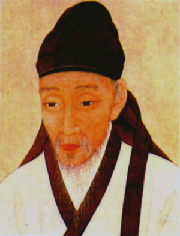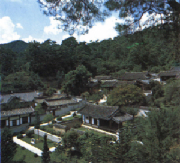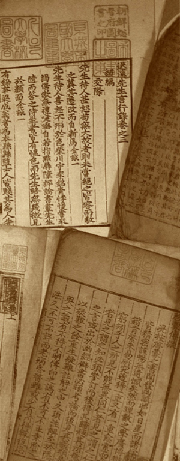|

The pattern Toe-Gye consists of 37 movements and is required
for advancement from 3rd geup (high blue belt) to 2nd geup (red belt). This pattern
is named for the pseudonym of Yi Hwang (Yi Toe-Gye), who lived from 1501 to 1570. The
37 movements of this pattern represent his birthplace on the 37th latitude in Korea.
The diagram, or shape, of this teul ( ± ) represents the Chinese character for scholar.

|
| Yi-Hwang (Yi Toe-Gye) |
Yi Hwang was born in 1501
in the province of Kyongsangdo. He was very intelligent; by the age of 34
he had passed his state exam for civil service. Because this exam was usually
not completed until a person was much older, he was held in high esteem for this accomplishment. During his youth he acquired the pen name Yi Toe-Gye, which means "returning stream". Although he was appointed to several high government offices during his life, he preferred to devote himself
primarily to his academic studies. His legacy was his philosophical teachings,
and his writings significantly influenced neo-Confucianism.
The foundation of Toe-Gye's school of thought was based on the philosophy of the 12th century Confucian scholar Chu-Hsi. Chu-Hsi established the concepts of "li" (reason or abstract form)
and "chi" (matter or vital force), and he proposed that these two concepts were responsible for all human characteristics
and the operation of the universe. As he defined the concepts,
they are very similar to the concepts of body and soul in Western philosophy and religion. The "li," however, is not totally synonymous with the idea of an individual soul. Instead,
it represents groups or models for each form of existence.

|
| Dosan Sowon built in 1552 at Andong |
Toe-Gye's school of thought supported the concept that the "li" was the controlling agent in the universe and that
the "chi" was a supporting component. Perfecting oneself through the building
of good moral character, learning, and reflection was stressed in the practice of the "li" school of thought. Its influence was strongly felt in the Kyongsang area where Yi Toe-Gye was born. The other major school stemming from the philosophy of Chu-Hsi was fostered by Yi I (see the section on
Yul-Gok), who proposed that the "chi" controlled the "li." This school stressed
the importance of education, experience, and practical intellectual activities.
Yi Yul-Gok, 35 years younger than Yi Toe-Gye, once visited him and they spent time discussing their philosophies.
Yi Toe-Gye became renowned
as a neo-Confucian scholar and produced many respected writings. In these works
he alluded to several concepts to convey his philosophy such as "musil" (diligence and realism, endeavor to be realistic,
or try to be true) and "shirhak" (practice learning). In 1558, he wrote a short
work entitled "Cha-Son-Huak" which became especially influential with Japanese intellectuals after its introduction to Japan
during the 17th century. Even 200 years later, in the 19th century, his teachings
were very popular among Japanese, especially Motota, the tutor to Emperor Meiji.

|
| Ancient book on Yi Hwang's Philosophy |
The teachings of Yi Toe-Gye
not only had appeal to the scholars of his time in Korea but soon attracted many senior government officials as well. Soon, government and political support increased for the formation of schools teaching
his concepts of the supremacy of practical ethics over metaphysics.
Yi Toe-Gye took advantage of his considerable influence when he became the head of a private school or shrine (Tosan
Sowon) in Kyongsang province in 1557. This shrine had been dedicated by its previous
instructor to the honor of a revered scholar who introduced the teachings of Chu-Hsi into Korea. It was a combination shrine, private study facility, school, and social gathering point for local
scholars. Yi Toe-Gye used his political ties to get royal patronage for the So-won
because it was also a shrine for a Confucian sage. This patronage, or tax-free
status, resulted in an influx of assets in the form of cash, cattle, land, slaves, grain, and books. As a result, this Sowon, and this type of educational system in general, proliferated and became
a predominant type of school in the Yi dynasty.
Yi Toe-Gye's leadership in
this school of thought pulled him into the political arena. The Yi dynasty was
characterized by political and religious reform with frequent conflicts between scholars and officials. As the underlying principle behind these changes, neo-Confucianism began to dominate the state creed and
politics of the Yi dynasty. Under this pressure, all of the Korean Buddhist sects
were forced to unify into one of two groups, Son (Zen) or Kyo. Because Buddhism
was viewed by strict neo-Confucians as a social evil, all but 18 of the nation's main Buddhist temples were closed. Political differences ultimately became focused on neo-Confucian concepts and their differences rather
than on political problems.

|
| Yi I (Yi Yul-Gok) |
Although he died in 1570, Yi Toe-Gye, through his teachings, had great historical impact on Korea during the years
that followed. A member of his school of thought, Kim Hyo-Won, occupied
a post of considerable power, enabling him to hire, dismiss, or veto all government appointments. When the leader of the opposition party, Sim Ui-Gyom, arranged to have his
brother succeed him, Kim exercised his veto power. This act polarized the entire government. Eventually every official had to become aligned with one side or the other or risk attack by both. Since Kim lived in the eastern quarter of Seoul and Sim lived in the western quarter,
the two factions became known as the Easterners and the Westerners. The
Easterners followed the teachings of Yi Toe-Gye while the Westerners followed the teachings of Yi I. This feuding continued long after Kim and Sim had disappeared from public life, and it often took
the guise of schemes designed to exile members of the rival faction, remove them from office, or get them executed
on false charges. Their philosophical differences tended to drive the two factions
further apart, increased the conflicts, and made the functioning of government virtually impossible. The day-to-day functioning
of the government and military became so impotent that resistance to the Japanese invasions of Korea by Hideyoshi
(200,000-man force) in 1592 and 1597, and the Manchu attacks in 1627 and 1637, were totally ineffective.
No doubt Toe-Gye would have been sorely dismayed had he lived to witness the political
problems that beset Korea in the name of his teachings. Despite the role it played in that dark chapter
of Korea's history, though, Toe-Gye's philosophy has made an enriching contribution to neo-Confucian thought.
His influence is still being felt in the 20th century in China, Korea, and Japan.
|

